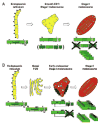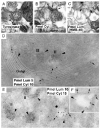The Silver locus product Pmel17/gp100/Silv/ME20: controversial in name and in function
- PMID: 16162173
- PMCID: PMC2788625
- DOI: 10.1111/j.1600-0749.2005.00269.x
The Silver locus product Pmel17/gp100/Silv/ME20: controversial in name and in function
Abstract
Mouse coat color mutants have led to the identification of more than 120 genes that encode proteins involved in all aspects of pigmentation, from the regulation of melanocyte development and differentiation to the transcriptional activation of pigment genes, from the enzymatic formation of pigment to the control of melanosome biogenesis and movement [Bennett and Lamoreux (2003) Pigment Cell Res. 16, 333]. One of the more perplexing of the identified mouse pigment genes is encoded at the Silver locus, first identified by Dunn and Thigpen [(1930) J. Heredity 21, 495] as responsible for a recessive coat color dilution that worsened with age on black backgrounds. The product of the Silver gene has since been discovered numerous times in different contexts, including the initial search for the tyrosinase gene, the characterization of major melanosome constituents in various species, and the identification of tumor-associated antigens from melanoma patients. Each discoverer provided a distinct name: Pmel17, gp100, gp95, gp85, ME20, RPE1, SILV and MMP115 among others. Although all its functions are unlikely to have yet been fully described, the protein clearly plays a central role in the biogenesis of the early stages of the pigment organelle, the melanosome, in birds, and mammals. As such, we will refer to the protein in this review simply as pre-melanosomal protein (Pmel). This review will summarize the structural and functional aspects of Pmel and its role in melanosome biogenesis.
Figures





Comment in
-
Pmel17: controversial indeed but critical to melanocyte function.Pigment Cell Res. 2006 Jun;19(3):250-2; author reply 253-7. doi: 10.1111/j.1600-0749.2006.00308.x. Pigment Cell Res. 2006. PMID: 16704461 No abstract available.
References
-
- Adema GJ, de Boer AJ, Vogel AM, Loenen WAM, Figdor CG. Molecular characterization of the melanocyte lineage-specific antigen gp100. J Biol Chem. 1994;269:20126–20133. - PubMed
-
- Badman MK, Shennan KI, Jermany JL, Docherty K, Clark A. Processing of pro-islet amyloid polypeptide (proIAPP) by the prohormone convertase PC2. FEBS Lett. 1996;378:227–231. - PubMed
-
- Bailin T, Lee ST, Spritz RA. Genomic organization and sequence of D12S53E (Pmel 17), the human homologue of the mouse silver (si) locus. J Invest Dermatol. 1996;106:24–27. - PubMed
Publication types
MeSH terms
Substances
Grants and funding
LinkOut - more resources
Full Text Sources
Other Literature Sources
Research Materials

